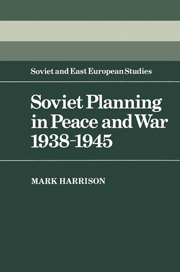Book contents
- Frontmatter
- Contents
- Dedication
- Preface
- Acknowledgements
- 1 ECONOMIC PLANNING AND THE SEARCH FOR BALANCE
- 2 THE COMING OF WAR: PLANS AND REALITIES IN 1941
- 3 THE SOVIET PRODUCTIVE EFFORT
- 4 THE SEARCH FOR ECONOMIC BALANCE IN WARTIME
- 5 SOVIET LESSONS FROM WORLD WAR II
- APPENDICES
- 1 Soviet arms production 1930–45
- 2 Soviet heavy industry output 1928–45
- 3 Soviet arms balances 1941–5
- 4 Composition of the USSR Sovnarkom 1938–45
- 5 Abbreviations and technical terms
- Bibliography
- Index
3 - Soviet arms balances 1941–5
Published online by Cambridge University Press: 29 October 2009
- Frontmatter
- Contents
- Dedication
- Preface
- Acknowledgements
- 1 ECONOMIC PLANNING AND THE SEARCH FOR BALANCE
- 2 THE COMING OF WAR: PLANS AND REALITIES IN 1941
- 3 THE SOVIET PRODUCTIVE EFFORT
- 4 THE SEARCH FOR ECONOMIC BALANCE IN WARTIME
- 5 SOVIET LESSONS FROM WORLD WAR II
- APPENDICES
- 1 Soviet arms production 1930–45
- 2 Soviet heavy industry output 1928–45
- 3 Soviet arms balances 1941–5
- 4 Composition of the USSR Sovnarkom 1938–45
- 5 Abbreviations and technical terms
- Bibliography
- Index
Summary
The purpose of an ‘arms balance’ is to reveal, in each period, the relationship between the initial stock of weapons, the additional supplies from domestic and external sources, the deployment and loss of available supplies, and the stock remaining at the end of the period. For Soviet arms in each successive phase of the war, fully reliable balances cannot be compiled, because essential data are lacking. As far as the changing stock of weapons is concerned, we are told of first-line force levels at various moments (see Chapter 3, Table 11), but we have no comparable information about second and third echelons and reserves. Appendix 1 provides us with information about additional supplies from Soviet sources in considerable detail, but comparable time-series for external supplies can only be estimated on the basis of a series of questionable assumptions. Evidence on the deployment of new supplies between the front and the rear, and on the rate of losses arising from different causes, is completely lacking. Of the consecutive assumptions required for us to proceed, some give rise to offsetting errors, some to multiplicative ones. The results must be considered in this light.
Official Soviet data on first-line force levels in Chapter 3, Table 11 provide the foundation for everything which follows; that is, this table defines the three weapons categories used (artillery and mortars, tanks and self-propelled guns, combat aircraft) and the periodisation (seven periods of variable length, but averaging six months each); in addition the data in the table are considered to be definitive except that, in accordance with notes to the table, the first-line deployment of tanks and combat aircraft on 22 June 1941 is revised upwards substantially in order to take into account the Soviet deployment of ‘obsolete’ types at the outbreak of war.
- Type
- Chapter
- Information
- Soviet Planning in Peace and War, 1938–1945 , pp. 256 - 266Publisher: Cambridge University PressPrint publication year: 1985



